Pick and Place Robot Market to Reach USD 7.4 Billion by 2032, Says Market.us Research Study | Analysis on Impact of US crises

Page Contents
Market Overview
Published Via 11Press: In 2022, the pick and place robot market was estimated to be worth USD 3.0 billion. By 2032, this market is predicted to reach its peak value of USD 7.4 billion at a compound annual growth rate (CAGR) of 9.6% between 2022 and 2032.
The global pick and place robot market is projected to experience tremendous growth over the coming years, driven mainly by increasing automation across various industries such as food & beverage, automotive, and electronics. Pick & place robots are used for repetitive tasks like sorting, packaging and assembling – thus reducing human errors while increasing productivity. Furthermore, with Industry 4.0 and Internet of Things (IoT) technologies becoming more widely adopted across businesses worldwide, this sector could experience substantial expansion.
One of the major drivers of this market is an increasing need for automation across industries such as automotive, electronics, food and beverage, and pharmaceuticals. Pick-and-place robots help improve efficiency, cut labor costs, and guarantee consistency in production processes. Another factor driving growth in this space is collaborative robots or cobots which are designed to work alongside humans; their flexibility and ease of use make them perfect for small to medium-sized businesses. Furthermore, advances in machine learning, artificial intelligence, and sensor technology have made these robots increasingly intelligent and autonomous – further fuelling demand.
Geographically, Asia-Pacific is expected to lead the pick and place robot market due to its extensive manufacturing industry and high demand for automation. North America and Europe are also expected to hold significant market shares due to their adoption of advanced technologies in these regions.
Would you like to access the statistical information, graphs, and key players' tactics? click here

Key Takeaways
- The global pick and place robot market is projected to experience rapid growth over the coming years, driven mainly by increasing demand for automation across various industries such as food & beverage, automotive, and electronics.
- Robots are used to automate repetitive tasks, such as sorting, packaging, and assembly. This reduces human errors while increasing productivity.
- The market is expected to experience significant growth due to the rising adoption of Industry 4.0 and Internet of Things (IoT) technologies.
- Asia Pacific is expected to dominate this market due to the presence of several manufacturing industries within the region.
Regional Snapshot
The global pick and place robot market is segmented into North America, Europe, Asia Pacific, Latin America, and the Middle East & Africa. Asia Pacific is expected to lead the market due to the presence of several manufacturing industries there; China, Japan, and South Korea will be major contributors to growth within this region. North America and Europe are expected to experience significant expansion due to increasing adoption of automation technologies across various industries.
Drivers
- Automation is on the rise across various industries such as food and beverage, automotive, and electronics.
- Pick and place robots are used to complete repetitive tasks like sorting, packaging, and assembling; thus reducing human errors and increasing productivity levels.
- Industry 4.0 and the Internet of Things (IoT) are becoming more widely adopted, leading to an exponential rise in pick-and-place robot demand within e-commerce businesses.
Restraints
- High initial investment costs.
- Limited flexibility of pick and place robots.
- Concerns regarding worker safety due to increased adoption of automation technologies.
Finally, the global pick and place robot market is expected to experience significant growth over the coming years, driven by rising automation demand across various industries as well as the adoption of Industry 4.0 and IoT technologies. Asia Pacific is predicted to lead this market due to the presence of several manufacturing industries there. Nevertheless, high initial investment costs and concerns regarding worker safety may hinder its expansion.
Opportunities
- Automation is on the rise across various industries such as manufacturing, packaging, and logistics.
- Furthermore, with the growing adoption of the Industrial Internet of Things (IIoT) and Industry 4.0, technologies comes an increased need for smart and flexible robots that can adapt according to changing conditions.
- Due to rising labor costs and shortages in many countries, automation is becoming more attractive to companies.
- There is also an increasing focus on safety in the workplace which has driven demand for robots that can work alongside humans safely.
Challenges
- Deploying pick-and-place robots requires a significant initial investment.
- Integration of robots into existing manufacturing processes and systems may prove challenging, necessitating skilled technicians to operate and maintain them.
- Limitations in certain applications where products differ significantly in size, shape, or weight can lead to concerns over job displacement and its potentially negative consequences for employment prospects.
Recent Developments
- Collaborative Robots or Cobots: Collaborative robots or cobots have become increasingly popular in the pick-and-place robot market. These robots are designed to work safely alongside humans, making them ideal for applications requiring human-robot interaction.
- Advanced Vision Systems: Advancements in computer vision technology have enabled pick and place robots to accurately locate and pick items of various sizes, shapes, and colors. This makes the robots more versatile and adaptable to various manufacturing environments.
- Modular Design: Many pick-and-place robots now feature a modular design, making them easily customized and reconfigured for different applications. Furthermore, this modular structure makes it simpler to replace parts or perform maintenance on the robots.
- Artificial Intelligence: Some pick-and-place robots now possess artificial intelligence (AI) capabilities, enabling them to learn from and adapt to changing manufacturing environments. This improves efficiency while reducing the need for human intervention.
- Integration with Other Technologies: Pick and place robots are increasingly being integrated with other technologies, such as automated guided vehicles (AGVs) and conveyor systems. This integration creates a more streamlined manufacturing process, eliminating the need for manual labor.
- Overall, these advancements have made pick-and-place robots more efficient, versatile, and adaptable to various manufacturing environments – leading us to expect continued growth in this market over the years ahead.
Key Market Segments
Type
- Articulated
- Delta
- SCARA
- Cartesian
Application
- Automotive and subcontractors
- Food & Beverage Packaging
- Electronics
- Metal and machining
- Plastic and polymers
- Pharma and Chemistry
Key Market Players
- Bosch Packaging Technology
- Yamaha Motor
- Kuka
- Kawasaki Heavy Industries
- ABB
- Codian Robotics
- Bastian Solutions
- JLS Automation
- McCombs-Wall
- FANUC
Report Scope
| Report Attribute | Details |
| The market size value in 2022 | USD 3.0 Bn |
| Revenue forecast by 2032 | USD 7.4 Bn |
| Growth Rate | CAGR Of 9.6% |
| Regions Covered | North America, Europe, Asia Pacific, Latin America, and Middle East & Africa, and Rest of the World |
| Historical Years | 2017-2022 |
| Base Year | 2022 |
| Estimated Year | 2023 |
| Short-Term Projection Year | 2028 |
| Long-Term Projected Year | 2032 |
Frequently Asked Questions
Q: What is a pick-and-place robot?
A: A pick-and-place robot is an industrial robot designed to pick up objects and move them to another location.
Q: In what industries do pick and place robots work?
A: They're used in a variety of industries such as manufacturing, packaging, logistics, food service, and beverage production.
Q: What are the advantages of pick-and-place robots?
A: Picking and placing robots can increase efficiency, cut labor costs, enhance product quality, and promote workplace safety.
Q: What products can pick and place robots handle?
A: Pick and place robots can handle a wide range of items, such as small electronic components, food items, and heavy industrial parts.
Q: Can pick and place robots work alongside humans?
A: Collaboration robots (cobots) are designed to work alongside humans, improving safety and flexibility in the workplace.
The team behind market.us, marketresearch.biz, market.biz and more. Our purpose is to keep our customers ahead of the game with regard to the markets. They may fluctuate up or down, but we will help you to stay ahead of the curve in these market fluctuations. Our consistent growth and ability to deliver in-depth analyses and market insight has engaged genuine market players. They have faith in us to offer the data and information they require to make balanced and decisive marketing decisions.